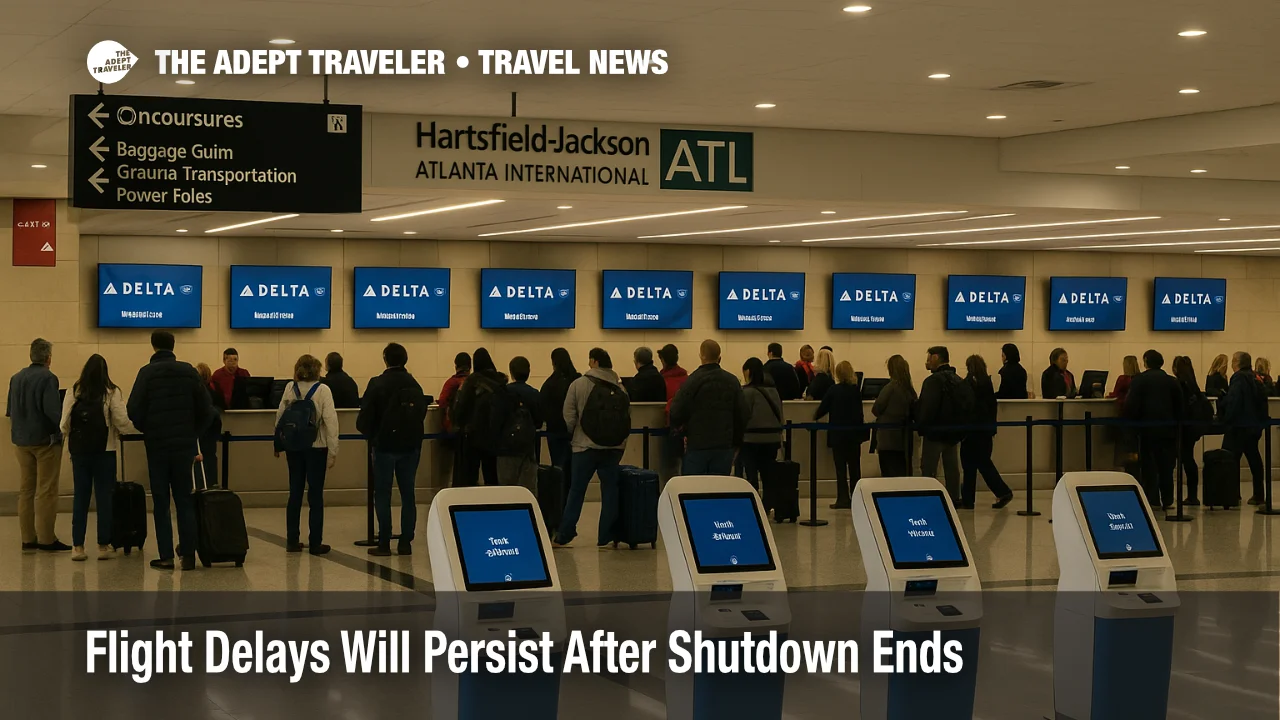Flight Delays Will Persist After Shutdown Ends

Key points
- FAA ordered cuts step up to 10 percent across 40 high-volume markets by November 14
- Airlines caution that schedules and crew plans will take days to stabilize even after funding resumes
- TSA and ATC staffing recovery will not be instantaneous, so expect longer lines and rolling ground delays
- Refunds apply for cancellations and significant delays, and many carriers have active change-fee waivers
Impact
- Expect Rolling Delays
- Ground delay programs and flow controls will continue while the FAA phases out mandated reductions
- Check For Waivers
- Use airline flexibility policies to move to earlier or less congested flights where possible
- Build Buffer Time
- Arrive early, especially at hub airports with known screening and traffic constraints
- Monitor Your Inbox
- Watch for retimes, aircraft swaps, and rebook options as schedules are re-threaded
- Mind Peak Days
- Thursday and Friday banks will be most vulnerable while crews and aircraft reposition
Air travelers should plan for several more days of disruption even if the federal shutdown is resolved today. Airlines and regulators spent the past week throttling the system to protect safety, with the Federal Aviation Administration ordering progressive schedule cuts that rise to 10 percent by November 14 across forty high volume markets. Carriers say those constraints, plus crews and aircraft out of position, will keep delays and cancellations elevated through the week even after funding resumes. Major outlets and airline memos echoed the same warning this morning.
FAA plan and where it bites
The FAA's emergency order laid out a phased reduction, 4 percent beginning November 7, 6 percent by November 11, 8 percent by November 13, then 10 percent from November 14 onward, with carriers submitting rolling seven day cut lists. The measures concentrate on the busiest parts of the National Airspace System, which means extended ground delay programs and holds at hubs like Chicago O'Hare, Atlanta, Newark, Washington, and San Francisco. The agency has also limited some visual approaches and squeezed commercial space operations into overnight windows to preserve controller bandwidth.
Why delays will linger after a deal
Even if appropriations pass, staffing and schedules do not snap back the same hour. Controllers and screeners return to pay status, however facilities still need to reset overtime rosters, and airlines have to re thread aircraft routings and crew legalities that were disrupted by days of flow programs and cancellations. Trade group Airlines for America said the shutdown's impact is cumulative, and it backed the FAA's safety first cuts while pressing for swift restoration of government functions.
What airlines are telling customers
Carrier operations leaders signaled that recovery will take time. In an internal memo reported today, American Airlines' chief operating officer called the recent cancellation waves unacceptable, while warning that controller constraints and FAA cuts will continue to shape schedules in the near term. Reuters and other outlets have tracked multi day totals in the thousands for delays and cancellations, underscoring that recovery will be measured in days, not hours.
TSA lines and airport checkpoints
Security screening has also been strained. Airports reported peak wait times that stretched well beyond normal standards during the shutdown, driven by absenteeism pressures among unpaid screeners. While back pay should reduce attrition risk once the government reopens, TSA throughput typically improves over days, not immediately, as staffing patterns normalize and overtime is reset. Expect bottlenecks to persist at larger hubs before throughput returns to typical levels.
Latest developments
This morning's reporting emphasized that even with congressional action advancing, airlines expect cancellations and delays to remain elevated for several days as the FAA winds down mandated cuts and carriers reposition. Travelers should watch for additional waiver expansions and rolling schedule trims on Thursday and Friday as the 8 percent and 10 percent reduction tiers take hold.
Analysis
The near term risk profile centers on hub peaks, first bank morning departures and evening connections where crew legality windows are tight. If you are connecting through one of the affected metroplexes, move to earlier flights with longer connects, or route around the most constrained facilities when possible. Where carriers have posted no fee changes, use them before departure to shift into protected windows or less congested times. Refunds remain available for cancellations and for significant delays under federal rules, and most airlines are proactively offering reaccommodation paths when flow programs extend.
Background, how FAA flow cuts work
When controller staffing cannot safely support planned throughput, the FAA implements ground delay programs and flow restrictions to meter demand into available capacity. Airlines then cancel or retime flights, usually targeting frequency rich domestic routes first to preserve long haul operations. The current emergency order formalized those reductions with percentage caps, which remain in force until facilities report stable staffing and acceptable delay metrics.
Final thoughts
The shutdown's end will help, however the flight network needs a few operating cycles to absorb crews and aircraft back into place. Plan conservatively this week, use waivers where offered, and build buffer time at the airport while the FAA steps down from the 10 percent reduction tier and airlines unwind their recovery plans.
Sources
- Emergency Order Establishing Operating Limitations on Operations in the National Airspace System
- U.S. Transportation Secretary Sean P. Duffy and FAA Administrator Bryan Bedford Outline Series of Measures
- Latest Data Shows Huge Impact of the Government Shutdown on Airlines and Our Customers
- US airline disruptions persist amid prolonged government shutdown chaos
- US flight delays, cancellations accelerate as air traffic controller shortages surge
- Trump threatens air traffic controllers who fail to return to work as flight cancellations jump
- Flight disruptions will persist even after shutdown ends, airlines warn
- American Airlines COO memo on shutdown related disruption, reported November 11, 2025
